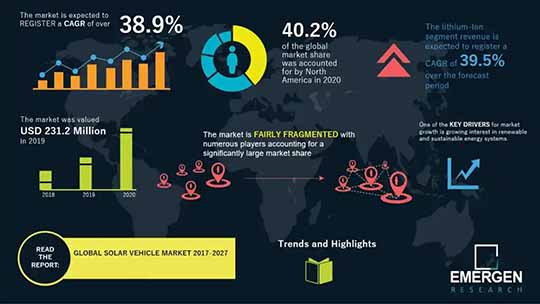The global solar vehicle market size is expected to reach USD 2,899.7 Million in 2027 at a robust CAGR of 38.9 during the forecast period. Steady market growth can be attributed to rising awareness about detrimental effects of air pollution on environment and rapidly depleting fossil fuel resources. Increasing initiatives undertaken to shift focus to renewable and eco-friendly energy resources is another major factor driving market growth. Increasing disposable income and increasing popularity of solar-powered vehicles in developing economies are some other key factors expected to propel market growth going ahead.
Stringent regulatory policies concerned with carbon emissions from vehicles powered by fossil fuels have been boosting sales of solar-powered vehicles globally. Increasing number of prominent automotive manufacturers have been focusing on research and development activities in solar power energy systems. Introduction of new and advanced solar-powered vehicles has brought dynamic changes in the market and this trend is expected to be prevalent going ahead. Original equipment manufacturers (OEMs) are investing in manufacturing highly efficient, upgraded, and cost-efficient solar vehicles to cater to increasing demand for solar-powered vehicles. The development of efficient and technologically upgraded solar panels and batteries is expected to boost sales and performance of solar vehicles to a significant extent going ahead.
However, high initial cost of highly efficient and advanced solar-powered vehicles is a key factor restraining market growth to an extent. Additionally, solar-powered vehicles can operate to a certain distance and exhibit lower operational efficiency and speed and these factors are expected to further restrain market growth to an extent during the forecast period.
Some Key Highlights in the Report:
- The monocrystalline segment is expected to account for largest revenue share over the forecast period. High purity of monocrystalline silicon confers high efficiency to monocrystalline panels and this has been boosting adoption of monocrystalline solar panels in the manufacturing of solar vehicles. This is expected to contribute to revenue growth of segment over the forecast period.
- Lithium-ion segment is expected to register a robust revenue CAGR of 39.5% over the forecast period. Growth of lithium-ion battery segment is driven by significant attributes of lithium-ion batteries such as high energy density, improved high-temperature performance, high specific-energy, and lower self-discharge rate.
- Passenger cars segment accounted for largest revenue share among other segments in 2020. OEMs are increasingly investing in R&D activities for manufacturing cost-efficient solar vehicles and this is expected to drive demand for solar-powered passenger cars over the forecast period.
- The battery electric vehicle segment revenue is expected to expand significantly during the forecast period attributable to increasing advancements in rechargeable batteries used in battery EVs that has led to production of energy-efficient and robust electric vehicles.
- Asia Pacific market revenue is expected to expand considerably over the forecast period attributable to rapid urbanization, increasing disposable income, and rising preference for environmentally sustainable energy-driven vehicles.
- Major companies of market include Sono Motors, Volkswagen, Toyota, Ford, Mahindra & Mahindra, Nissan, General Motors, Fiat Chrysler Automobiles, Venturi Automobiles, and Hanergy Thin Film Power Group.
- In March 2020, Centrica, which is the U.K’s largest energy company, and Volkswagen Group, which is one of the world’s prominent automotive manufacturers, signed a three-year partnership agreement to accelerate adoption of electric vehicles across the United Kingdom by providing domestic charging hardware solutions for new EV owners.
For more exclusive insights, access Sample PDF here: https://www.emergenresearch.com/request-sample/535













